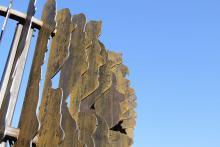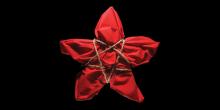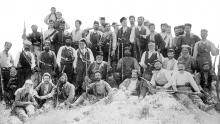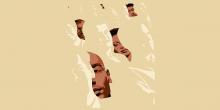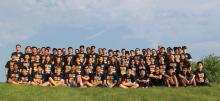
Walk along the trails dotting the Lehigh Valley and you will come across them—small birds with oversized round heads, black cap and bib, white cheeks and gray back, wings and tail. The black-capped chickadee and its relative the Carolina chickadee, and their interbreeding habits, are of particular interest to evolutionary biologist Amber Rice.
Rice is interested in speciation, the evolution of new species, and her research seeks to understand the ecological and evolutionary processes underlying speciation, from reduced flirting between two groups to the end stages where two species start to mate together again, or hybridize.
Lehigh University is located within the “hybrid zone,” a narrow band from northern New Jersey to Kansas where this population of hybridized chickadees live, which presents a unique opportunity to study them. Supported by a grant from the National Science Foundation, Rice and her team are conducting behavioral studies of chickadees. The researchers capture black-capped and Carolina chickadees and their hybrids in the field, then transport them to an aviary located at Iacocca Hall, where they test the birds’ learning, memory and problem-solving abilities.
“We’ve got some initial results that indicate the hybrids are worse at remembering the location of a food item,” says Rice, assistant professor of biological sciences. “They are also worse at problem solving than the pure species. We think this could be detrimental to their survival because they rely on memory for their food in the winter. In the fall, they store food throughout the environment, like squirrels. They’re scatter hoarders. Like squirrels, they cache their food for the winter, then they have to remember where they stored it. If the hybrids can’t remember well, it could be a problem for their survival. Lower hybrid survival can help to maintain these birds as two separate species.”
To test the birds’ spatial memory, Rice uses a wall containing 60 identical rubber pockets, each covered by a white craft ball. One of the pockets contains a wax worm, a highly desired food item. The birds are introduced to the wall of pockets in the same manner once a day for seven days. This offers the team an opportunity to observe how well the birds remember the location of the worm, which is always concealed in the same pocket.
To test their learning skills, the team presents the birds with a new problem to solve. A worm is placed into a small well drilled into a block attached to an aviary wall. The birds are trained to feed from the well by regularly placing worms in it. During the test, researchers place a circular washer with a transparent coating over the well. The birds can see a worm through the washer, and to solve the problem, they must determine how to move the washer in order to access the worm.
“One of the cool things we’re finding with both these tests is it’s the female hybrids that do worse on the tests,” Rice says. “That suggests interesting things to us because there’s a common pattern in speciation research where if one of the sexes in the hybrid group is worse, it’s the sex with the two different sex chromosomes, which is males in mammals. In birds, it’s the opposite—and our initial findings show females do worse.”


